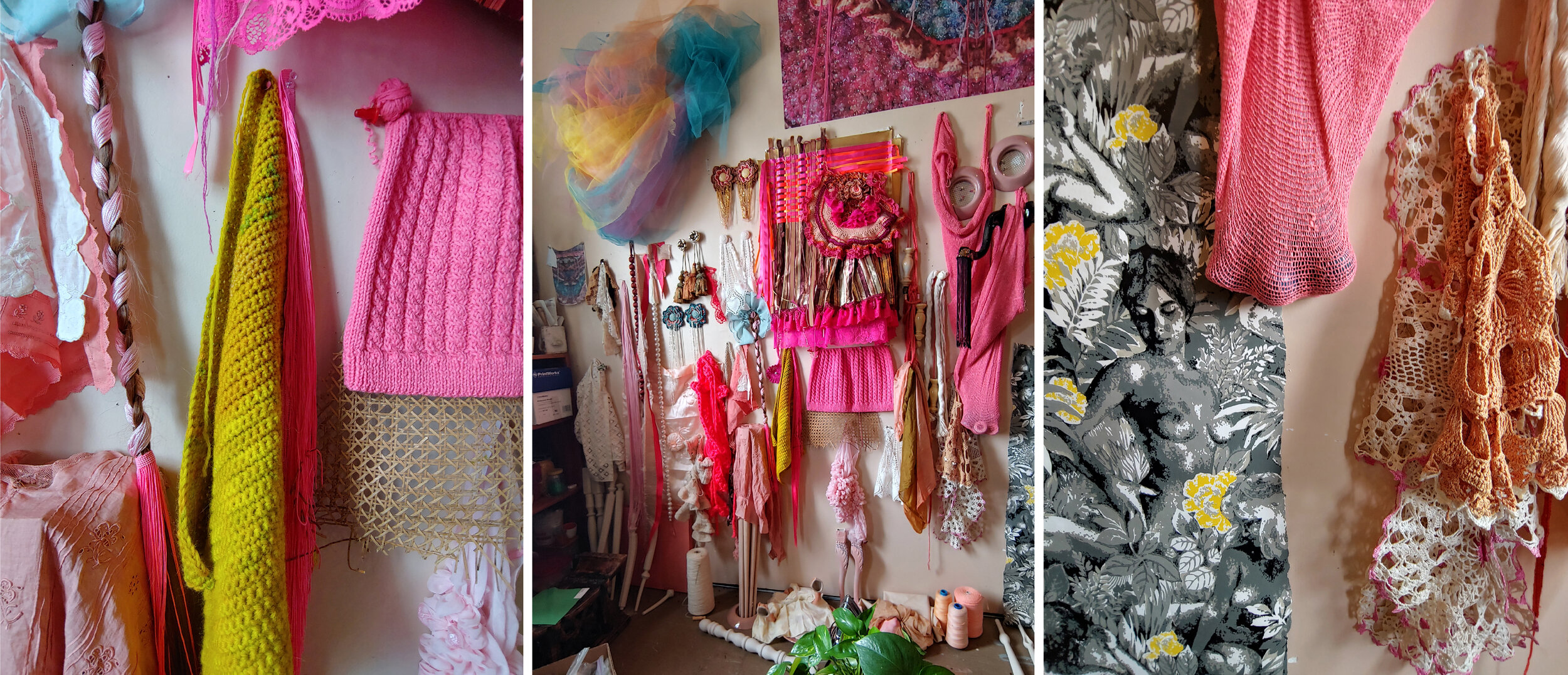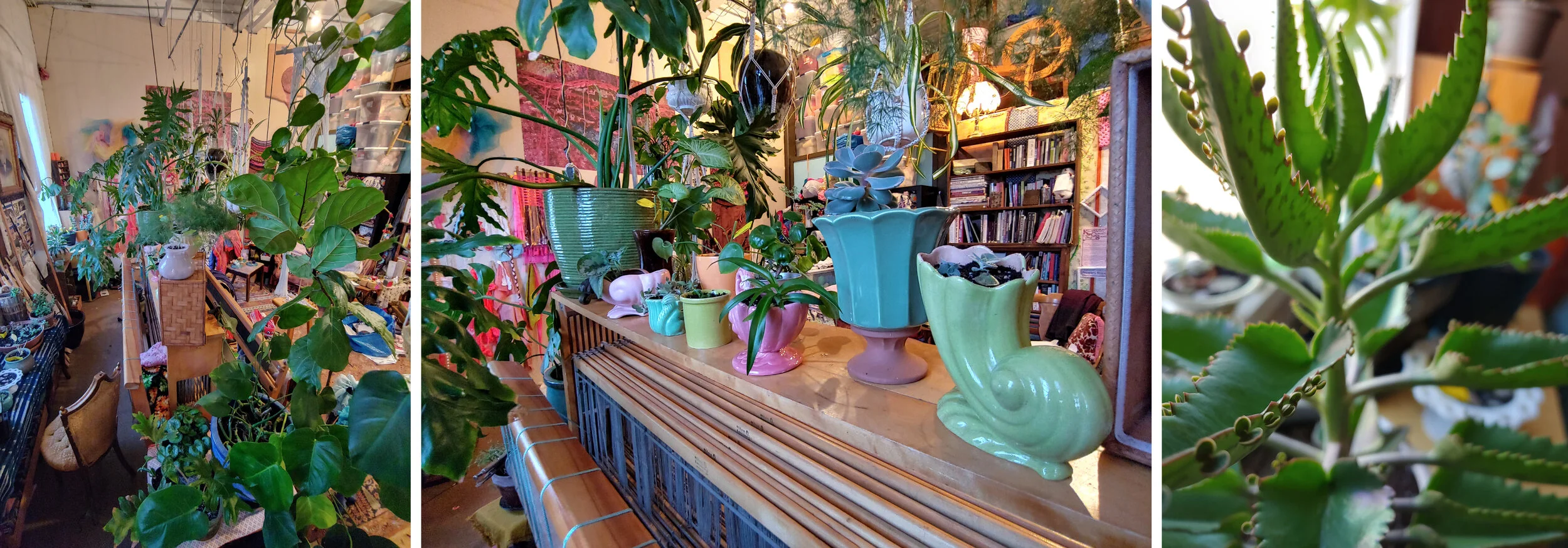Growing up in Brockton, MA, Samantha was the youngest member of a tempestuous lower-middle class family. Drawn to the materials and processes that have historically lived outside of an “Art” context, she strives to make work that can live in and speak to the different worlds of 'high' and 'low.'
“I make--slowly--with/through craft. Making slowly is a personal act of resistance against the fast-paced, multi-tasking, product-driven world in which I find myself.”
As a multimedia artist, Samantha engages with craft and textile processes as a survival mechanism, aesthetic, and a conceptual strategy. Through these modes of making, she is able to explore different social constructs associated with the decorative: gender, class, professional/hobbyist, and the hierarchical categories of taste and morality. Sam received her MFA from The School of the Museum of Fine at Tufts University Arts, Boston and her undergraduate degree from Massachusetts College of Art; and is currently a part-time lecturer at the SMFA.
For more information, please see: https://samanthafields.com and on Instagram @lady__of__leisure.
Samantha Fields, Origin II. Fabric yarn, beads fringe, Vitreous China, fingernail polish. Dimensions: 60" x 36" x 12". Image courtesy of the artist.
First, and most importantly, how are you doing? How are you navigating the highs and lows?
Most days I am tired, overwhelmed.
I am allowing a new level of slow and still to settle into my life, and not try to fill the voids that have opened but allow them to become spaces of growth. Places to hold and process all of the fires that have been burning, the virus, systemic racism, police brutality, and the all-around destruction of our souls. Things have always been heavy, and unjust but these past 4 years lots of veils have been rent, and it is not so easy to look away unconsciously or consciously and think I will deal with this later. But in the midst of holding all of this in the front of my brain, I have also relearned the meaning of the word retreat. In the past, the word has had a softer comfortable meaning, but now I am reminded one retreats from battle when one needs a moment of restoration, healing, a new game plan, so they are not completely overpowered.
Samantha Fields, The Graces, 2020. Vitreous China, coffee tables, pothos, grow lamp. Dimensions variable. Image courtesy of the artist.
It's my experience that most artists engage with some level of self-isolation in their day to day art practice. Has this been your experience? And if so, have you found these innate rhythms to be helpful during this larger, world-wide experience of isolation?
At first it was kind of nice to have a ton of things cancelled and to not have to interact so much with people, I tend to be an introvert. I take copious amounts of time alone, but it is also not heathy for me to isolate myself because I find relationships and interactions with others overwhelming and a lot to process. I can avoid people, but in my avoidance, I am missing out on many deep and meaningful interactions that impact me for the better. I need others to mirror myself back to me (zoom doesn’t cut it).
Work in progress. Image courtesy of the artist.
It would be great if you could briefly talk us through your practice. Understanding it is integral to appreciating the multivalence of your work.
Drawing from historicized images of women in art, mythology, fiction, pop culture and our collective imagination I use cloth as portrait, as performance, as container. Weaving together a complex hermeneutic loop of string and fabric, discordant elements pushing, pulling, bulging, dripping, tightly bound, and completely unraveling, simultaneously true and not true, moving back and forth between a celebration and a rejection, a critique upon and a claiming of female identity.
Using a visual language that has been associated with the feminine and relegated to the superficial, the work with its opulence of ornament, crochet ruffle upon ruffle, beads, sequins, and embroidery elevates what has been traditionally considered a de-evolution of a sophisticated western society. The work owns a particular aesthetic of cheap opulence, a glorious beauty in low materials and accessible processes.
These materials and processes hold conceptual weight, giving me the space to play, experiment, and meander with the form the materials take, which then nuances, flips, exaggerates, and questions that original conceptual weight.
Samantha Fields, The Bathers. Wall paper, Vitreous China. Dimensions variable. Image courtesy of the artist.
Has any of your imagery shifted in a reflection to what's currently happening?
The imagery in the work hasn’t shifted and I don’t see that happening, although I am not opposed to it. My work usually is not made around a topic per say, I don’t sit down with an idea and execute it or even start with a solid image in mind. My practice is like a continuous experiment with materials and techniques. That is not to say the work is not informed by events and research, it’s just not usually a one-to-one equation. My studio is packed with materials I have collected over 20 years. Things in my studio tend to move around and gather into piles and these piles get added to and subtracted from until those things need to be made into something. I am usually working on three to six pieces at a time I am continuously making every day, and through this persistent making ideas and concepts get refined, but never solidified. I never want them to be too solid. I am always holding on to a space for viewers to move around in, to swim in, for some kind of poetics even paradox, uncertainty. I work so hard on a kind of precision so things can be imprecise, just the right word, color object to open it wide. I want my work to be an invitation and not a pronouncement. With that said, I am sure that living through this time will impact the work in the future, I am just not sure how.
Gatherings on my studio wall. Image courtesy of the artist.
Are you thinking differently? Coping differently? Inspired differently?
I don’t know that I am thinking differently but there seems to be a pointed urgency in me to make generous spaces for people to see themselves and others, to create a middle. I am overwhelmed by the intense polarization and demonization of the other in this country at this particular time. In my different projects, teaching, and future dreams, I am compelled to attempt to create spaces of contemplation, slowing down, shared research, shared stories, spaces of potential expansion and growth. A space where we are learning how to be with others rather than doing for others.
Ars Poetica #100: I Believe
Poetry, I tell my students,
is idiosyncratic. Poetry
is where we are ourselves
(though Sterling Brown said
“Every ‘I’ is a dramatic ‘I’”),
digging in the clam flats
for the shell that snaps,
emptying the proverbial pocketbook.
Poetry is what you find
in the dirt in the corner,
overhear on the bus, God
in the details, the only way
to get from here to there.
Poetry (and now my voice is rising)
is not all love, love, love,
and I’m sorry the dog died.
Poetry (here I hear myself loudest)
is the human voice,
and are we not of interest to each other?
Samantha Fields, The Venus of Ramsdale. Mixed media, textiles, vitreous china. Dimensions: 78" x 66" x 78". Image courtesy of the artist.
What do you think or hope will be different after this crisis has passed?
My hope is that we would realize much of life and the things we think we need, we can happily do without. I would love it if humanity, myself included, could come to a place where we realize that we don’t need the constant new thing. That what we are, more than what we produce, project, or purchase - these things do not give us our worth, but our worth is inherent to being alive. Understanding this in our core would help us love each other better and care for our world in a more thoughtful way. Sadly, I think the only way we come to these kinds of understandings is when we get a stick caught in our spokes.
Samantha Fields, Eve After Fragonard. Jacquard weaving, synthetic foliage, beads, chain. Dimensions:14’x3’x’6”. Image courtesy of the artist.
What is bringing you solace, or even joy, in this moment?
Friends that practice hope in word and action, poetry, watching things grow, drawing lines/meditation, mending and as always cats.
Mending
Drawing lines/meditation
Cat(s)
What research or writing are you doing that you find compelling?
I have been reading a bunch of essays on the power and use of craft/making in teaching, and our lives in general. I am getting ready to teach a class entitled “Embodied Resistance Through Textile Practice” which looks at craft as a political and personal tool. Specifically, how fiber/textile practice has acted as a form of resistance, protest, and self-empowerment through-out history and in our current culture, exploring questions such as: how can textile practice function as a means of subversion as well as self-care? How have community and empathy been created through the practices of sewing, knitting, crocheting, embroidery, dying and weaving? What does soft intervention into politicized realms look like, what kind of space can it create? This research has been one of the things that is brining me solace.
Samantha’s collection of plants. “The first half hour of studio time is dedicated to tending and being with my forest.” Image courtesy of the artist.











